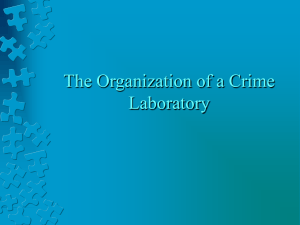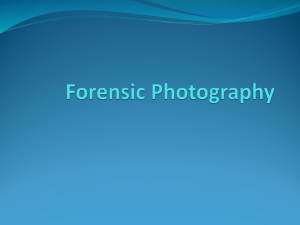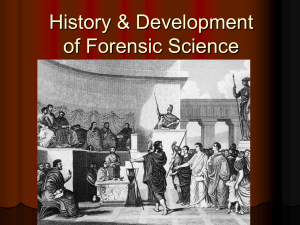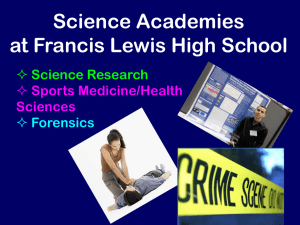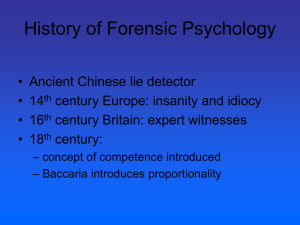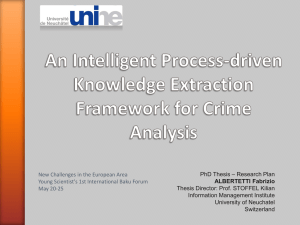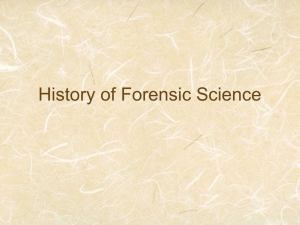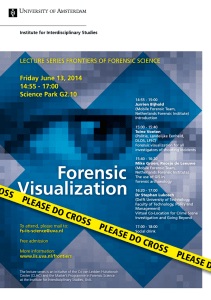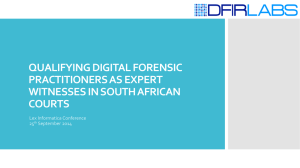Introduction to Criminal Investigations
advertisement
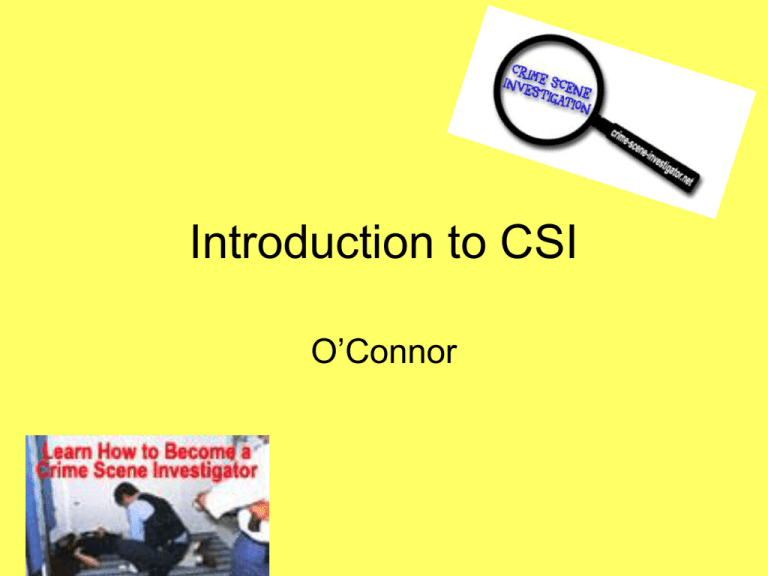
Introduction to CSI O’Connor Forensic Science • Its broadest definition says it is the application of science to law. • Forensic science applies the knowledge and technology of science to the definition and enforcement of such laws. Forensics has diverse professions: • • • • • Criminalistics Engineering Science General Forensics Jurisprudence Odontology • Pathology/Biology • Physical Anthropology • Psychiatry & Behavioral Science • Questioned Documents • Toxicology History • Mathieu Orfila (1787-1853) The father of forensic toxicology, published the 1st works on the detection of poisons and their effects on animals. • Leone Lattes (1887-1954) Dr. Latte's expounded on a discovery by Dr. Karl Landsteiner that blood could be typed. In 1915 Dr. Latte developed blood typing from dried blood, a procedure still in use today & developed first crime lab. The functions of a forensic scientist: • Provides analysis of physical evidence • Provides expert testimony • Furnishes training in recognizing, collecting, and preserving physical evidence at crime scenes Basic Services Provided by a Crime Lab • Physical Science Unit - applies principles & techniques on chemistry, physics, & geology to identify & compare crime scene evidence. • Biology Unit - for the purpose of identification & DNA profiling of dried blood stains & other body fluids, hairs, fibers, & botanical materials. • Firearms Unit - for the examination of firearms, discharged bullets, shells, cases, & other types of ammunition. • Document Examination Unit - to ascertain authenticity & source of questioned documents & hand writing analysis, indented writings, obliterations, erasures, & burned/charred documents. • Photography Unit - to examine & record physical evidence via digital imaging, infrared, ultraviolet & x-ray photography. This area also prepares photographic courtroom presentations. Optional Services • Toxicology Unit - to ascertain if body fluids & organs show the presence or absence of drugs or poisons. This is usually a separate laboratory under the guidance of the medical examiner. • Polygraph Unit - this unit is more of a tool for the criminal investigator than the forensic scientist. • Voiceprint Analysis Unit - this unit compares voice taped recordings to suspects. This analysis compares unique voice patterns of the suspect to the recording in evidence. • Evidence Collection Unit - are the people dispatched to a crime scene to collect evidence that will be processed later at the crime laboratory. • Forensic Pathology - this unit investigates the sudden, unnatural, unexplained, or violent deaths. An autopsy is usually performed to obtain the answer. • Forensic Anthropology - deals with the examination & identification of human skeletal remains. • Forensic Entomology - the study of insects & their relation to a crime scene investigation. • Forensic Odontology - regards the identification of remains too badly decomposed via dental examination. • Forensic Engineering - this unit is concerned with failure analysis, accident reconstruction, causes & origins of fires or explosions. Reasons for the rapid growth of crime laboratories in the United States since the late 1960’s • Increasing volume of physical evidence recovered from crime scenes as a result of rising crime rates. • The need to perform chemical analysis on drugs, coupled with a significant increase in illicit drug seizures. Cont. • Advances in scientific technology have provided forensic scientists with many new skills & techniques to extract meaningful information from physical evidence. • Supreme Court decisions have enhanced the rights of the defendant. Decisions, such as those ensuring a defendant’s right to counsel & the right to remain silent, have encouraged police agencies to place a greater reliance on scientific investigative techniques. • A more recent impetus leading to the growth & expansion of crime laboratories has been the advent of DNA profiling. • Since the early 1990’s, this technology has progressed to the point at which traces of blood, semen, stains, hair, & saliva residues left behind on stamps, cups, bite marks, etc., have made possible the individualization or near-individualization of biological evidence. • To meet the demands of DNA technology, crime labs have expanded staff & in many cases modernized their physical plants. Forensic Scientists As Expert Witnesses • Must be able to evaluate evidence based on specialized training & experience • Be able to express an opinion as to the significance of the findings. The effectiveness of an expert’s testimony is almost always dependent on: • The experience of the expert • The ability of the expert to talk in clear, concise language • The educational background of the expert • The scientific validity of the tests used The case of Frye v. United States deals with the legal issue of: General acceptance of scientific principles. Its known as the “Frye Standard”. The judicial case that set forth the current guidelines for determining the admissibility of scientific examinations in the federal courts is: Daubert v. Merrell Dow Pharmaceuticals, It said that the Frye standard is not a prerequisite to the admissibility of scientific evidence. The trial judge is ultimately responsible for what is reasonably accepted. Guidelines for using Daubert • 1. Whether the scientific technique or theory can be (& has been) tested. • 2. Whether the technique or theory has been subjected to peer review & publication • 3. The technique’s potential rate of error • 4. Existence & maintenance of standards controlling the technique’s operation • 5. Whether the scientific theory or method has attracted widespread acceptance w/in relevant scientific community. The following are a sample of services normally considered within the expertise of the forensic scientist: • • • • • Drug identification Wood comparisons Document examination Latent fingerprint examination DNA comparison



